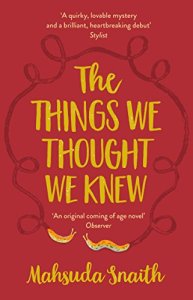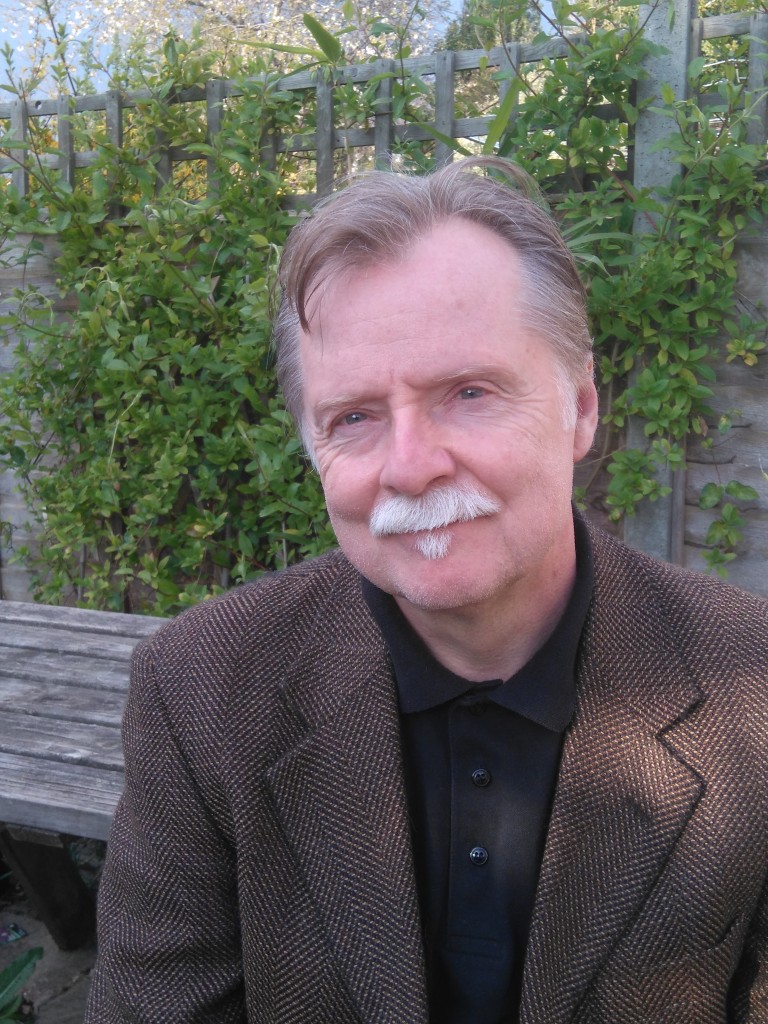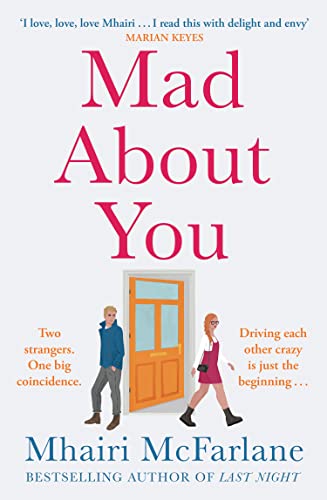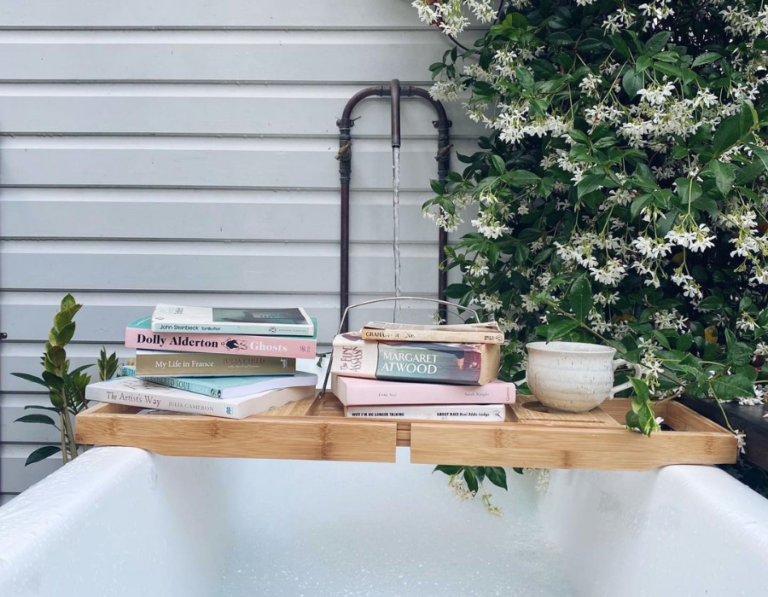The first memory I have of you is all knickers and legs. You had flipped yourself into a handstand and couldn’t get back down. We became best friends, racing slugs, pretending to be spies – all the things that children do.
Image ©Andy Lo Po/ The Novelry
2. Do you remember when you came up with the first story idea that would ultimately go on to be published as a novel? How did you know this was the idea that was worth telling?
To celebrate I have a Q&A with Mahsuda Snaith, author of The Things We Thought We Knew.
Throughout my childhood and early teens, I used to make my own tape-bound books and write versions of other people’s novels in them. I wrote a Point Horror-esque story about a character who had a monster living inside them (real rather than a metaphoric one) and I also wrote a story that was heavily, if not entirely, influenced by ‘Anne of Green Gables’. But when I turned sixteen, I thought it was time to write my own novel and I immediately began to use elements of my life as a British-Bangladeshi girl growing up in a single parent family on council estate. Connecting to those elements gave me an instant familiarity to the story, and I found the writing and ideas kept on flowing. I finished that ‘novel’ (which is a stretch of the term as I wrote it in one draft with no editing and very few words) and put it away in a box. It wasn’t until many years later when I came back to that book and saw it still had so much promise. The story, characters and setting were still strong and, although a lot of work needed to be done to craft that first draft into the final one, it eventually became my debut novel, The Things We Thought We Knew.
I genuinely believe one of the reasons we have survived as a species is because of our ability to tell stories. If someone tells you to not go in a house because it’s dangerous it’s not half as effective as if someone tells you, ‘Anyone who goes into that house, never comes out alive’. Stories are warnings, the tales we pass on so that future generations won’t repeat the same mistakes. But they are also pathways to empathy. In my second novel How to Find Home, I wanted to write about a main character who was homeless primarily so that I could understand what it was like to live a homeless life. Through research and talking to those who had experienced it, I was able to discover many things about the realities of homelessness. If I’d put what I’d learnt in report a few people may have read it, but by incorporating those discoveries in a story, people relate to the subject matter in a different way. They walk in the shoes of your main character and they wonder how they would deal with the circumstances they face. In short, a story makes things personal. The connection of the reader to the story is just as important as the telling of a story. It is a truly social act.
About the Book
4. As well as being a novelist, you have written short stories for print as well as audio. What appeals to you about these formats?
Ten years later, eighteen-year-old Ravine Roy spends every day in her room. Completing crosswords and scribbling in her journal, she keeps the outside world exactly where she wants it; outside.
6. National Storytelling Week is all about the oral tradition of storytelling. Do you think it’s important to keep this tradition alive, when we have so many other ways of consuming and telling stories these days?
1. When did you first realise that you were a storyteller?
*content was provided on behalf of The Novelry. I have not been paid to host this content and I am not affiliated with them in any way*
3. Do you have a story of yours that you are most proud of?
About the Author
But as the real world begins to invade her carefully controlled space, she is forced to finally confront the questions she’s been avoiding. Who is her mother meeting in secret? Who has moved in next door?
I’ve always loved writing short stories and often used breaks between big writing projects to refine and work on short pieces. It’s challenging to write short stories but so incredibly satisfying to fit a whole world into a limited number of words. I also love reading short stories for this reason; being able to consume a whole story in one sitting can feel like an achievement. When I wrote The Panther’s Tale, I was particularly aware of how the words sounded as I knew it was following the storytelling tradition and would be listened to primarily on audio. I therefore read a lot of the work out aloud as I was writing, listening for rhythms and deciding where and how surprises would be revealed. It’s a technique I use whenever I write now because, even when the word is written, the reader can hear the rhythm of the story in their mind.
Mahsuda is a tutor at The Novelry. Offering support for beginner and established authors at any stage of their writing career, The Novelry will take writers from the very kernel of an idea through to a polished manuscript ready for literary agent submission. With mentoring from bestselling authors and editorial advice from leading industry professionals, The Novelry is the writing school recommended by leading literary agents.
Having a variety of ways of consuming stories is always important because it is with variety that you reach a wide audience. Whether it be via books, audio stories, T.V. or your next-door neighbour telling you about their childhood, the stories we absorb change us. I was a primary school teacher for many years and there was always something wonderful about reading a story out loud to group of children and watching the wonder on their faces. We had storytellers come into the schools sometimes with nothing but a few props who could captivate a hall filled with children of all ages. This is no mean feat! There is a magic to storytelling. If done correctly, it can be truly spell binding.
5. Why do you think stories are important?

And why, all those years ago, when two girls pulled on their raincoats and wellies and headed out into the woods did only one of them return?
Mahsuda was the winner of the SI Leeds Literary Prize 2014, the Bristol Short Story Prize 2014 and has led creative writing workshops in universities, hospitals, schools and a homeless hostel. She is a commissioned writer for the Colonial Countryside project and her short story ‘The Panther’s Tale’ is included in Hag: Forgotten Folktales Retold (Virago).

7. What do you hope readers will take away from your writing?
I was commissioned by Audible to retell a forgotten folktale from the Midlands. The story I was given was about the legend of Chillington Hall where the owner, John Giffard, owned a menagerie of exotic animals. As legend tells it, one of those animals managed to escape into a nearby forest. That animal just happened to be a panther. It was such surprising and wonderful material that it instantly set my imagination alight. I had just finished a project where I had researched and written short stories about the British Raj and had read folktales of Bangladesh for my research. After reading folktales from England and the Midlands in books by the Society of Storytellers, it almost felt instinctual to use the tropes of South Asian and English folktales – the use of ordinary folk as well as royalty, animals, curses etc. – and have a panther who is actually an Indian princess who can morph into human form. I called this story The Panther’s Tale and it was included in HAG: Forgotten Folktales Retold. This is one of the stories I’m most proud of because, not only did it feel like it was being written by someone else with all the parts seemingly clicking into place as I wrote, it also addresses so much about the status of women in society and the ways different histories can overlap within a format that is, hopefully, captivating to hear or read.
Listen for your voice. When you begin, you will emulate the stories that have inspired you (I did this myself with my tape-bound books). It’s a part of the process. But after you’ve let those pieces breathe, go back to that writing and see where your voice stands out, see which parts you enjoy reading, see what elements of the story you still feel a connection to. Think about your interests and life experiences, think about what made you begin telling stories in the first place, then, with everything you’ve learnt, write the story only you can write.
It began for me when stories were read out loud at school. I remember sitting on the carpet and listening to picture books then chapters of longer books when we were older. I was a really shy kid but I was an active daydreamer so I remember relaxing back and imagining it all happening in my mind. Soon, I was creating my own stories and playing out scenes in my imagination. In fact, I still do this! I am a definite believer that daydreaming about story is counted as writing time.
8. If you had one piece of advice for someone wanting to tell a story of their own, what would it be?
Mahsuda Snaith was an Observer New Face of Fiction in 2017. Her debut novel The Things We Thought We Knew (Black Swan) was released in 2017 when she was named an ‘Observer New Face of Fiction’. Her second novel How to Find Home (Black Swan) was chosen as a BBC Radio 4 ‘Book at Bedtime’.
Today sees the start of National Story-telling week, a celebration of the oral tradition of storytelling, and takes place for a full week at the beginning of February each year. Stories are told in schools, theatres, pubs, village halls, community centres, and are a way of bringing people together.
It was never my intention, but after writing a body of work, I came to realise that the stories I gravitate towards are the hidden, sometimes buried stories, of the people around us. I hope that my stories give readers glimpses of less visible worlds as well as seeing a part of themselves in fiction that they have never seen represented before. But most of all I want readers to be entertained! To be taken on a journey that gives them the highs and lows of life, to laugh, to cry but, most of all, to feel. And all within the comfort of their armchair.








